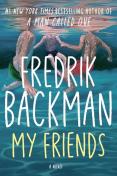
by Fredrik Backman
Hardcover- $20.99
Click on the ORANGE Amazon Button for Book Description & Pricing Info
Overall rating:
How would you rate this book?
Member ratings
I loved this book - it was charming, heartwarming, and heartbreaking all at the same time. The author has such a way with words you feel you really know each and every character. It is a coming of age story that takes you back to your childhood and reminds you of the special bonds you can form with childhood friends.
My Friends, Fredrik Backman, author; Marin Ireland, narrator
This story will reach out and grab the reader right from the start. A group of troubled teens are just trying to manage to live in a world that does not welcome them. They loved going to the pier and jumping into the sea with abandon. There, they were free, free from their lives that seemed doomed to failure, lives that would be dead ends unless they could get away from where they lived and those with whom they lived. Together, Ali, Yoar, and Ted decide to save their friend Kim-Kim, the one most vulnerable, the one they thought would not survive in their town. He had the talent to succeed beyond their borders, and they were determined to give him the push needed to get away. They pooled their resources and mischievously devised a plan to set him free. They wanted him to enter an art contest. Kim-Kim is a good artist, though his cruel teacher shames him and tries to stifle his talent. For the contest, he paints a picture of the pier and his three friends in a moment of happiness, but the sea is what most people see in the painting, not the small detail that was most important to the friends, their simple joy before any of them came of age!
Fast forward two decades and meet Louisa and Fish, two teens living in the cruel foster care system. They struggle to survive, until one of them does not. Fish had given Louisa a postcard that had a picture of Kim-Kim’s now very famous painting of the sea. Louisa imagines the story of the three teens she sees in the painting, the teens most people do not even notice. When Fish is no longer there, Louisa runs away from the foster home. She is so sad. She is only a day away from her 18th birthday and freedom, but freedom to do what? Louisa does not have social skills. Her imagination tends to the crude and inappropriate at times. When she decides to go to a museum to see the real painting that is on the postcard, her life changes. In the museum, she gets into an altercation because a nasty woman decides, without reason, that Louisa is only there to destroy the painting that she treasures. Soon, Louisa is running again. She runs into a man she believes is homeless, and they have an immediate connection. It is at this point that the story begins in earnest. The man she has just met is C. Jat, AKA Kim-Kim, now a famous artist whose paintings are worth millions. C. Jat recognizes that Louisa is “one of them” and he is ecstatic.
Unfortunately, C. Jat is dying. He treats the coming end of his life without fear. He believes he has lived a long life, though he has not lived all that many years. To Louisa, just about four decades of life means the person is very old. She does not know that C. Jat had asked his friend Ted to buy back that very painting of the sea, and so using all of C. Jat’s assets, Ted who loves C. has done just that. Now, on his deathbed, C. Jat asks Ted to give the painting to Louisa because she is “one of us”. When he finds her, Ted is conflicted with all kinds of emotion, but he passes the painting to her, anyway. He has to fulfil C. Jat’s wishes. Louisa insists that she does not want it. She is on the run, has no home, doesn’t know what to do with the actual painting she has worshipped for so long. She is just happy that she got to see it and to meet the artist. She begs Ted to take it, but he wants to leave it with her and return to his home, the place that is also home to the pier that all of them so loved. Louisa does not let him abandon her like so many others before him. She follows him to the train and manages to convince him to take her with him, so he can help her sell the painting worth a small fortune. Their journey is amazing as he reveals the story of how the painting came to be, and he reveals the story of the lives of the teens pictured in it. Louisa does not want to hear anything but happy endings, but she keeps insisting on learning more anyway.
C. Jat and his friends came from households that were challenging in different ways. Their friendship sustained them through some really difficult situations. This story illustrates their love and loyalty for each other, loyalty that overcame their fears, fostered their dreams, exposed their sexuality, their frailties, and their capacity for all kinds of mischief, mischief that often wandered into the realm of vandalism. They were not perfect, but then, who is? All they really wanted were normal lives, lives not beset by abusive parents, bullying classmates, unfit educators and adults that tormented them, but they knew there was no promise of a better life for them. They were trapped where they were. Still, they teased each other, told gross jokes, swam in the sea together and brought each other the joy that was absent from their lives in most other places.
These teens often veered off the straight and narrow path. They did not behave within the confines of society. They created the rules for their own reality. They wanted the freedom to be who they really were, not to be what society wanted them to be. It took years for some of them to realize that they could reach for a better life, a life in which they were free to try to realize their dreams, unimpeded by the standards demanded by society. They could overcome the fears and trepidation that held them back. Their friendship had always kept their heads above water. Could it do that again?.
This story was overwhelmingly sad. I failed to find the “aha” moments of humor, though I knew that some of the dialogue was meant to be humorous. I found it somewhat crude. Although it seemed to encourage creative and individual ideas, it also seemed to subtly accept or encourage unacceptable behavior, the kind of behavior that seemed to go beyond acceptable mischief for anyone. I felt that the consequences for some of the more outlandish behavior did not have enough gravitas. Regardless of the hopelessness of an individual’s hopes and dreams, there has to be some expectation of decorum for a society to survive. Driving without a license, glorifying graffiti, uncalled for violent behavior, breaking and entering, shoplifting, etc., without facing real repercussions, treats the vandalism and disobedience as just a joke. Although famous artists and writers are quoted, and I realized that Basquiat may have painted in, and on, unacceptable places, his life came to an early and sad end, after a meteoric rise to fame, so is it wise to glorify such behavior? The poet Oliver’s quotes were admirable, though, since I found them motivational, and I thought that verbalizing the expressions like I love you and I believe in you, inspired trust and supported attributes to be encouraged. I just wished that in the end that I didn’t’ feel like finding "one of us" was often finding someone who respected no rules and someone who laughed at accepted standards of behavior. I didn’t think that was such a good message to encourage. For me, stolen flowers were not adopted flowers, cockroaches and skulls were unusual choices for someone to paint as things of beauty, since that was the antithesis of how they were normally described, and while I understand that art is an acceptable way to express alternative ideas coupled with imagination and creativity, I believe that even art should have some boundaries. While art should be for everyone, I didn’t think its purpose was to attempt to offend everyone.
The story made me think of how I grew up. I never knew anyone who was a victim of domestic abuse, although I did know kids who were bullied. I knew that some kids bent the rules, some were unwed mothers, some were interested in same sex relationships, but those situations were largely kept secret. Alcoholism was rare and drug use was unheard of in my day. The times were different. Most of us self-disciplined. Louisa and Kim-Kim were largely undisciplined.
The book illustrated greed and the power of money, the cruelty of adults and children in positions of power, the power someone stronger has over someone that is weaker. Power can be abused by those in authority. It illustrated how that power might be used for good, instead. It illustrated the power of friendship and loyalty, inspiration and encouragement, love and trust. Backman showed that bad people can do good things, and good people can do bad things. No one is all one way. Does doing one good thing redeem a bad person? This book makes the point that it is important to feel accepted and welcomed, to be “one of us”, and. I wondered, can all of us join that club? In the end, are we all flawed? Are we all looking to find a way to simply be ourselves? Backman reveals ordinary people as he exposes ordinary life with all the shortcomings and strengths. I was glad that in the end the book did seem to offer hope for those who marched to the beat of a different drummer.
I love Fredrik Backman, but this is not his best book. I found it very slow going and you really don't get the point until the end. Still a good read, but not book club material.
Book Club HQ to over 90,000+ book clubs and ready to welcome yours.
Get free weekly updates on top club picks, book giveaways, author events and more








